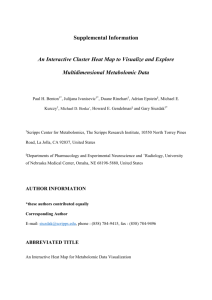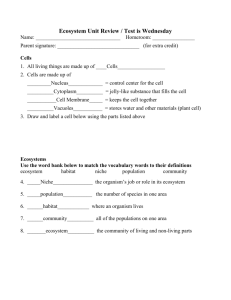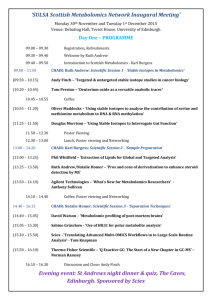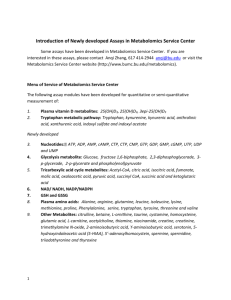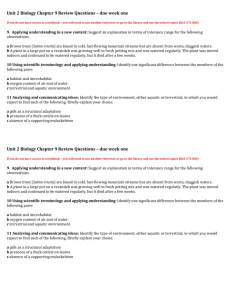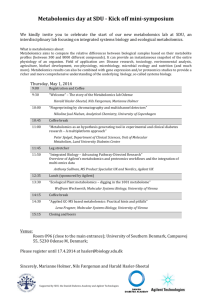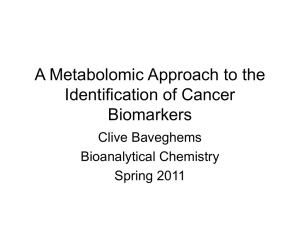4.0. Minimum Reporting Standards for Environmental Metabolomic
advertisement
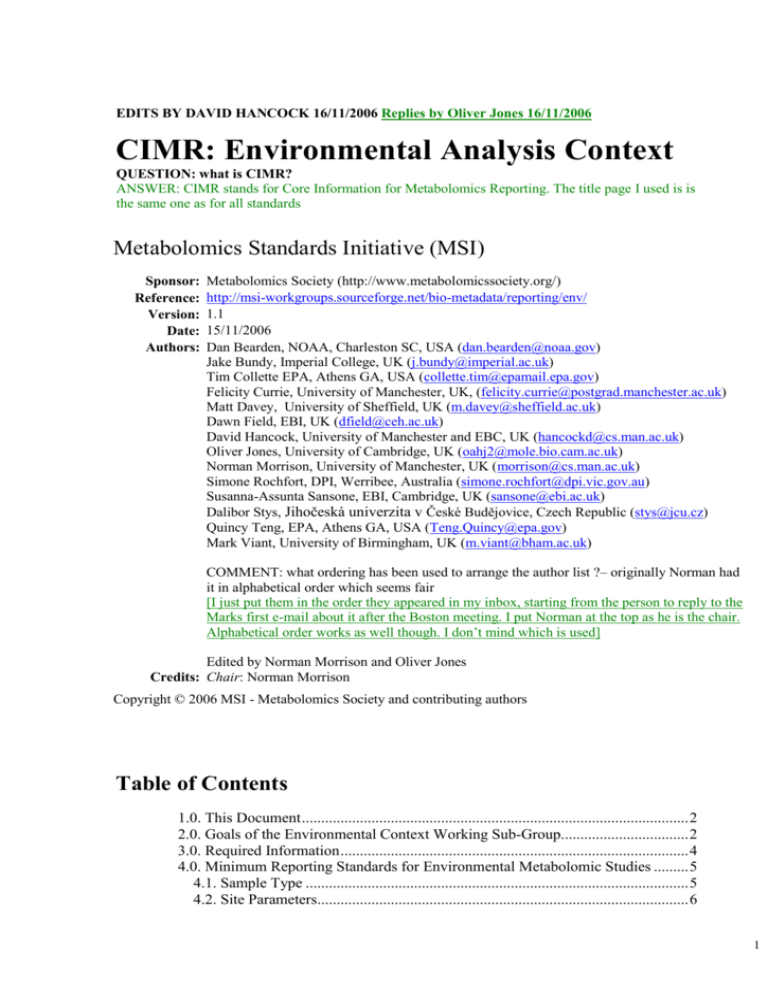
EDITS BY DAVID HANCOCK 16/11/2006 Replies by Oliver Jones 16/11/2006
CIMR: Environmental Analysis Context
QUESTION: what is CIMR?
ANSWER: CIMR stands for Core Information for Metabolomics Reporting. The title page I used is is
the same one as for all standards
Metabolomics Standards Initiative (MSI)
Sponsor:
Reference:
Version:
Date:
Authors:
Metabolomics Society (http://www.metabolomicssociety.org/)
http://msi-workgroups.sourceforge.net/bio-metadata/reporting/env/
1.1
15/11/2006
Dan Bearden, NOAA, Charleston SC, USA (dan.bearden@noaa.gov)
Jake Bundy, Imperial College, UK (j.bundy@imperial.ac.uk)
Tim Collette EPA, Athens GA, USA (collette.tim@epamail.epa.gov)
Felicity Currie, University of Manchester, UK, (felicity.currie@postgrad.manchester.ac.uk)
Matt Davey, University of Sheffield, UK (m.davey@sheffield.ac.uk)
Dawn Field, EBI, UK (dfield@ceh.ac.uk)
David Hancock, University of Manchester and EBC, UK (hancockd@cs.man.ac.uk)
Oliver Jones, University of Cambridge, UK (oahj2@mole.bio.cam.ac.uk)
Norman Morrison, University of Manchester, UK (morrison@cs.man.ac.uk)
Simone Rochfort, DPI, Werribee, Australia (simone.rochfort@dpi.vic.gov.au)
Susanna-Assunta Sansone, EBI, Cambridge, UK (sansone@ebi.ac.uk)
Dalibor Stys, Jihočeská univerzita v České Budějovice, Czech Republic (stys@jcu.cz)
Quincy Teng, EPA, Athens GA, USA (Teng.Quincy@epa.gov)
Mark Viant, University of Birmingham, UK (m.viant@bham.ac.uk)
COMMENT: what ordering has been used to arrange the author list ?– originally Norman had
it in alphabetical order which seems fair
[I just put them in the order they appeared in my inbox, starting from the person to reply to the
Marks first e-mail about it after the Boston meeting. I put Norman at the top as he is the chair.
Alphabetical order works as well though. I don’t mind which is used]
Edited by Norman Morrison and Oliver Jones
Credits: Chair: Norman Morrison
Copyright © 2006 MSI - Metabolomics Society and contributing authors
Table of Contents
1.0. This Document .................................................................................................... 2
2.0. Goals of the Environmental Context Working Sub-Group................................. 2
3.0. Required Information .......................................................................................... 4
4.0. Minimum Reporting Standards for Environmental Metabolomic Studies ......... 5
4.1. Sample Type ................................................................................................... 5
4.2. Site Parameters................................................................................................ 6
1
CIMR-Environmental
4.2.1. Parameters Common to all Study Types .................................................... 6
4.2.2. Additional Parameters for Aquatic Samples .............................................. 7
4.2.3. Additional Parameters for Terrestrial Samples .......................................... 7
4.3. Details of Specimens....................................................................................... 8
5.0. Additional Information ....................................................................................... 8
6.0. Bibliography ....................................................................................................... 9
1.0. This Document
This document forms part of the standards for reporting metabolomics experiments
developed under the Metabolomics Society (http://www.metabolomicssociety.org/
Metabolomics Standards Initiative (MSI). It should be read in the context of top level
document for those standards.
The current version of the document is work in progress.
The scope of our effort is to identify, develop and disseminate a core set of reporting
requirements [I would argue that ‘descriptors’ are not the same as ‘reporting requirements’
– descriptors are formally defined terms that can be used when reporting something]
[Maybe we could remove the word descriptors here?] necessary for the consistent
annotation of environmental metabolomic experiments. This working group considers
environmental metabolomics as the application of metabolomics to the fields of
environmental biology and toxicology [do we need to make a distinction between the two
?]. [Yes I think we do, they are not the same thing].
The aim is not to be prescriptive in how one should perform a metabolomic experiments,
but to formulate a minimum set of reporting requirements that describe said experiments
(what they are, what material were used, and how they were actually executed).
Consequently, there will be no attempt to restrict or dictate specific practices, but to
develop consistent and appropriate descriptors [see above] to support the dissemination and
re-use of metabolomic data. Such reporting standards will specify the data identified as
necessary for adequate and correct reporting in a range of identified contexts, such as
submission to academic journals and public databases. The group also recommends that
data exchange standards be developed in order to provide a transparent technical
vehicle which meets or exceeds the requirements of reporting standards. It is also
stressed that the requirements below are merely a minimal list and so not exhaustive.
COMMENT: I think we need to be more consistent in our use of the terms: descriptors,
standards and requirements. I suggest that there is a difference between semi-formal (i.e.
natural language) descriptions of what should be reported about a study, and formal
definitions of terms and compositions of those terms.
[I agree perhaps we could decide on this as a group]
2.0. Goals of the Environmental Context Working
Sub-Group.
The ECWSG seeks to:
2
CIMR-Environmental
I. Work cooperatively on a consensus document for a minimum set of reporting
requirements needed to enable the interpretation of the results of the metabolomics
based experiment generated in an environmental context unambiguously and
potentially to reproduce the experiment. to evaluate, understand, reproduce, compare
and re-investigate [what does this mean? Do we mean discover new information, or
validate existing information] metabolomic data generated in an environmental
context.
[To me this means validate existing information, for instance, if you are reviewing a paper
or want to repeat the work.]
II. Represent the views of community members working in the area of environmental
biology [see point about toxicology above] [see answer about toxicology above]
using metabolomics approaches in an unbiased and open fashion. The group will
engage with environmental metabolomics practitioners through an iterative process
of use case provision and validation of selected descriptors [see previous comments
about requirements,standards and descriptors]. [see answer about requirements etc.
above]
III. To evaluate previous and relevant standardisation efforts in environmental
toxicology and biology, including similar work in genomics, transcriptomics and
proteomics studies.
IV. Interact with the MICheck (micheck.sf.net) project as well as with individual
technology specific groups (i.e. MGED, HUPO-PSI, GSC). The group recognises
that the larger scientific community will best be served if the resulting specification
overcomes duplications across omics domains where commonality of the concepts
exists.
V. Evaluate our reporting requirements in the context of the other biological context
working groups with an aim to identify any overlaps / gaps in our reporting.
The ECWSG identifies four possible scenarios for environmental investigations:
1. Field Trials - Investigations in which a sample is taken directly from the field
2. Field to Lab - Investigations in which a sample is taken from the field and
conditioned in the lab under controlled conditions
3. Lab to Field - Investigations in which a sample is taken from the lab and
conditioned in the field under semi-controlled conditions.
4. Lab Investigation - Investigations in which a sample is lab reared or obtained from
a standard provider and conditioned in the lab under controlled conditions.
COMMENT: Is this list exhaustive? For instance “field to lab to field” or “lab to field to
lab” scenarios? I wonder whether we need to worry about this; but instead provide
templates for describing: “field info”, “lab info”, “capture info”, “release info” with which
any permutation of lab and field could be represented?
[REPLY: This is what we came up with and discussed quite extensively at the
teleconference, but I think either would be OK.]
3
CIMR-Environmental
Furthermore, the ‘environment’ of an organism(s) described as part of an investigation
using metabolomic technologies falls into three broad categories:
A. Uncontrolled Environment. The environment of the organism has not been
artificially modified for the purposes of the investigation (e.g. point 1 above).
B. Semi-controlled Environment. The environment of the organism has been partially
artificially controlled for the purposes of the investigation (see points 2 & 3
above).
C. Controlled Environment. The environment of the organism has been fully
artificially controlled or recreated for the purposes of the investigation (see point 4
above).
*Biotic Environment. We recognise [I actually liked this part better how it was originally
but I don’t think it makes that much difference] that an organism can have a ‘biotic
environment’, where the environment of an organism is another organism (i.e. in a parasitic
relationship). This scenario necessitates a nested description of the environment, including:
a description of the biotic environment of the primary organism and that of the host. This
‘use case’ scenario is considered less common in metabolomic experiments than in other
‘omic technologies.
3.0. Required Information
The minimal information set for reporting the samples in environmental metabolomic
experiments builds upon the general biological practice of reporting biological experiments
in scientific journals in a way that the ‘materials and methods’ section should include
sufficient information to allow the experiments to be repeated' ('Instructions to authors,
ASM' - http://www.journals.asm.org/). These include aspects such as:
Species/strains/bioresource
Source of the strains
Experimental design
COMMENT: Are not the last three items in this list actually part of ‘experimental design’?
[I think you are right here and have changed it accordingly.]
These aspects are considered to be general aspects that are reported in every biological
scientific paper/experiment, and are not addressed by this subgroup. However, scientific
journals also ask that authors describe those conditions that are critical to the experiments
performed in larger detail. Below we have identified those factors that are critical to
environmental metabolomic experiments, for which the materials and methods used [not
just the methods, but the materials], [I agree and have changed this] should be described in
larger detail.
The challenge therefore, is not to capture everything, but to provide a framework where the
environmental features considered relevant to a particular sample – which will be highly
context dependant – can be captured in a structured and extensible manner.
Metabolite levels can be perturbed by many different factors which may be unrelated to the
study being undertaken. Consequently these factors must therefore be taken into account
when analysing the resulting metabolomics data. Therefore please report the data
4
CIMR-Environmental
requirements outlined below as accurately as possible. All information outlined below
should be considered as required (if applicable) unless marked in italics, in which case it is
recommended further information but it is not automatically required.
[I don’t understand this bit – are we saying that external stimuli need to be recorded?]
[No, not at all; just that they must be taken into account by metabolite levels can be
perturbed by many different factors which may well be unrelated to the study. They must
therefore be taken into account when analysing the results]
4.0. Minimum Reporting Standards for
Environmental Metabolomic Studies
Sources:
The International Council for the Exploration of the Sea (ICES) Integrated
Environmental Reporting Format document [1]
Data reporting requirements from the PETRAEA project [2]
Plant Information Management System (PIMS) Database Schema [3]
Protocols for Standard Measurements at Freshwater Sites [4]
[5] and [6]
4.1. Sample Type
Is the sample
Environmental (e.g. terrestrial or aquatic)[ I agree with Dawn, this list should be
longer otherwise the reader thinks we have divided the world into just two
categories]
[Well essentially it is divided into three very, very general categories, terrestrial, aquatic
and airborne. This step was just to start the process off. We could add extra categories
(such as arboreal or airborne) here but will anybody actually be sampling from the latter
and don’t forget we also have a more specific section on environment/habitat type in
section 4.2.1.]
or
Laboratory based (e.g. cage, biosphere, aquarium, agar broth (see points 2, 3, 4 and
B and C in section 2.0)
COMMENT: what about the scenarios discussed in Section 2? I am not convinced that
dividing the sample this way adds any value. I prefer the original proposal that the
environment of sample be described, whether that environment be wild (natural) or
artificial. Many (if not most) of the same factors that might be of interest irrespective of the
type of environment that the sample came from.
5
CIMR-Environmental
[Reply: I strongly disagree here I think it adds a lot of value. It is also not new. This was
discussed extensively on the e-mail correspondence where I thought there was a fairly clear
consensus that a ‘one size fits all approach’ was not the way forward. There are clearly a
lot of factors relevant to terrestrial samples, which are not relevant at all to aquatic samples
and vive versa. I can’t actually think of any more environment types that don’t fall into
either of these two general categories. For instance, rivers, lakes and even pore water come
under aquatic, while soil, desert, polar, urban, fields and woods etc. come under terrestrial.
Remember, the general idea behind the set up was that a researcher submitting a paper
online would start by saying of the sample was aquatic or terrestrial and depending on the
answer would be given the specific parameters for each one automatically.]
4.2. Site Parameters
4.2.1. Parameters Common to all Study Types
Environment/habitat type, e.g. marine, freshwater, river, lake, ocean, sediment,
sediment pore water, sediment, field, intertidal zone, soil, grassland, desert, polar,
urban etc. (see points 1,2,3 and A and B in section 2.0) COMMENT: these
environment types might also be artificially recreated in the lab to the extent that
the same cannot discern the difference. Also, this list doesn’t cover arboreal or
airborne samples.
[The list is not meant to be exhaustive. I take your point about recreating the environment
in the lab but I still think that scenario would come more under the in vivo group’s
standards that have already been developed].
6
Geographic location (latitude and longitude in degrees/minutes/decimal minutes)
National Grid Reference
Sampling dates and/or times if a time course experiment is being run.
( Perhaps these should be collapsed into a single requirement, as it stands we don’t
define what we mean by time, to me this arrangement implies that sampling
occurred between two time points on a single day) [I agree and have changed it]
Supplier name and details if organisms are obtained from a standard provider
(what about the lab->field scenario) [I agree and have changed this section]
Concentration of any pollutants known (e.g. heavy metals). If samples are dosed
please provide details of the compound, exposure route, dose, dose volume [is this
different to dose? And how does it relate to concentration, e.g. we might know the
amount of mercury in the soil but not know how much the earthworms are eating],
duration of dosing, dosage vehicle (perhaps remove the ‘relevant to the study’
clause, who is to say what pollutant is relevant?) [Good point. the section is now
changed]
Time elapsed since an identifiable event, i.e. time elapsed since dose of
environmental toxicant (this should be part of the above parameter) [I am not sure
about this the identifiable event does not have to be dosing of a pollutant, it could
be since the sun set or the tide went out]
Growth conditions (perhaps this is part of the [? – if you mean part of weather then
I don’t agree since growth conditions could also include things like nutrient levels
etc.]
Weather ( e.g. raining, snowing, sunny)
CIMR-Environmental
Lunar phase
I wonder whether these parameters need rearranging into more than one category, this
seems to be somewhat of a melange of environmental information, organism information
and experimental information.
[Well since these parameters were designed to apply to all study types it is perhaps not
surprising that they are a bit of a mix.
We should also stress that whatever list we generate is not exhaustive, merely a minimal
list of things. [I agree and have put this at the end of section 1.0]
4.2.2. Additional Parameters for Aquatic Samples
Temperature (air and water)
Water depth
Specimen was submerged/emerged
Water salinity
Water pH
Dissolved and or total organic carbon level
Substrate type and organic carbon content (if using benthic organisms)
Tidal phase (if applicable)
Relevant water quality criteria. Minimum to include following values, suspended
solids, five day biochemical oxygen demand (BOD5), nitrate (including
ammoniacal nitrogen) and phosphate levels.
Oxygen content (DOC) and possibly other ‘standard’ measures of water quality?
[I agree but I don’t think we should use DOC for dissolved oxygen, since it also stands
for dissolved organic carbon? I think Biochemical Oxygen Demand (BOD5) might be
more useful here as well as others now listed above]
It is perhaps somewhat restrictive to introduce separate requirements for ‘aquatic’ and
‘terrestrial’ environments. I have no doubt that experimentalist will be able to find that
their particular set-up will fall between any potential cracks that we leave. For example,
does the shoreline count as aquatic or terrestrial?
[Again I was under the impression we had already agreed this on the e-mail discussions. I
do not think it is restrictive.
Whether the shoreline counts as aquatic or terrestrial would depend on the tidal phase
(which we have already required) and also where on the shoreline took the sample from on
the shore. I think all this can already be specified from the standard.]
4.2.3. Additional Parameters for Terrestrial Samples
Temperature (air and soil)
Altitude
Inclination
Aspect (does this refer to direction relative to the sun?) [I took this from the
PETRAEA standard. I believe it refers to the direction and angle to which a
particular
mountain
or
hill
faces
http://en.wikipedia.org/wiki/Aspect_%28geography%29]. Perhaps
could clear this up].
e.g.
Matt
Substrate type
7
CIMR-Environmental
Substrate organic carbon content and pH (why specify carbon in particular?)
[The organic carbon level is standard required parameter for environmental studies
because it will affect how any pollutants move without the system.]
Collection conditions e.g. humidity, precipitation, wind speed (Beaufort scale) and
direction [good point, this is now changed]
Image data, for example links and references to photographs of plant samples
taken in the field during collection may also sometimes necessary for detailed
identification of individual organisms. For example, time course studies on wild
plant populations.
4.3. Details of Specimens
Sample identification
Genus/species of specimen
Common name of specimen
Weight of specimen
Age of specimen
Sex of specimen
Stage of development
Ecotype
Genotype
Condition of specimen
Method of preservation
Method of shipping from environment to laboratory
Method of storage in laboratory
Acclimation procedure if specimens are moved from the field to the laboratory or
vice versa
COMMENTS:
It is not clear to me what the relationship between sample and specimen is.
[I agree this could be unclear. To me the sample type refers to the area the specimen was
gathered in while the specimen is the organism itself. I’m not sure how to change things to
make it clearer yet though].
Shouldn’t information about replication and pooling be recorded in the description of the
experimental processes? Otherwise we are mixing up environmental reporting with other
aspects of the experiment.
[Hmm, tricky but I think you are probably right here and I have changed it accordingly]
Further to my comments above about the lab/field issues, I would suggest that this list is
decomposed into several sections; information about the material (independent of its
location, namely the name and phenotypic data) and information about how it was gathered
and prepared for removal to the lab, or vice versa.
[I agree. The document is work in progress and once we have all agree on exactly what
needs reporting we can focus on how best to display the requirements.]
5.0. Additional Information
8
CIMR-Environmental
[Please be aware that there are additional requirements necessary for the processing of
samples (e.g. extraction methods and analytical technologies used). These are detailed
on the MSI webage at http://msi-workgroups.sourceforge.net/.]
. [defined where?]. [This is not defined yet I suggest we just say something like ‘as
detailed on the MSI webpage at http://msi-workgroups.sourceforge.net/ as above]
Perhaps replace this list with a more general paragraph emphasising the need for data to
also comply with reporting standards from relevant other groups, citing examples.
[I agree and have changed it]
6.0. Bibliography
1. The International Council for the Exploration of the Sea (ICES) Integrated
Environmental
Reporting
Format
document
(available
at
http://www.ices.dk/env/repfor/ERF322.doc).
2. Data
reporting
requirements
(http://www.petraea.shef.ac.uk/)
from
the
PETRAEA
project
3. Plant Information Management System (PIMS) Database Schema (available at
http://www.bioinf.shef.ac.uk/pims/images/FieldDB_new.png)
4. Sykes, J.M., Lane, A.M.J. and George, D.G. (Editors), 1999. Protocols for
Standard Measurements at Freshwater Sites. The United Kingdom Environmental
Change Network. Institute for Terrestrial Ecology, Grange-over-Sands, UK, 134
pp.
5. Cech,
T.R., Sharing Publication-Related Data and Materials:
Responsibilities of Authorship in the Life Sciences. Available at
www.nap.edu/books/0309088593/html
6. A. Brazma, P Hingamp, J Quackenbush, G Sherlock, P Spellman, C
Stoeckert, J Aach, W Ansorge, C A Ball, H C Causton, T Gaasterland, P
Glenisson, F C P Holstege, I F Kim, V Markowitz, J C Matese, H
Parkinson, A Robinson, U Sarkans, S Schulze-Kremer, J Stewart, R Taylor,
J Vilo & M Vingron. Minimum information about a microarray experiment
(MIAME)—toward standards for microarray data, Nature Genetics, vol 29
(December 2001), pp 365 - 371.
9
